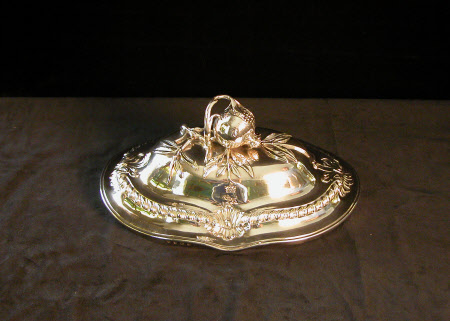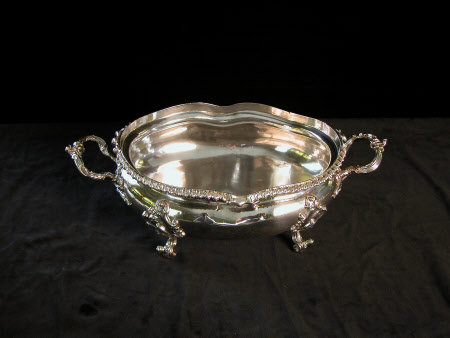Oval tureen
William Cripps (fl.1731 - 1767)
Category
Silver
Date
1757 - 1758
Materials
Sterling silver
Measurements
21.3 x 37.1 x 18.4 cm
Place of origin
London
Order this imageCollection
Ickworth, Suffolk
NT 852087
Summary
Oval tureen, sterling silver, marked by William Cripps, London, 1757/8. The body of the tureen is raised and is of shaped oval bombé form with a cast gadroon-and-scroll border applied at the rim. It rests on four cast scroll-on-ball feet with scrolling cartouches extending onto the body of the tureen and there are two cast leaf-and-scroll handles. The domed cover is raised and conforms in shape to the base. It has a large wire applied at the rim, a seamed short bezel and an intermediary band of chased gadrooning with shells at the centre of all the sides. The handle is cast and is in the form of a pomegranate on a stalk with foliage asymmetrically arranged over the plain top of the dome. Heraldry: The tureen base is engraved on one side only with the quartered arms, supporters and motto of the 2nd Earl of Bristol. The cover has, also on one side, the Hervey crest beneath an earl’s coronet. Hallmarks: Fully marked on the underside of the tureen and on the bezel of the cover with the maker’s mark ‘WC’ in a rectangular punch (Arthur Grimwade, London Goldsmiths 1697-1837, London 1990, no. 3058), lion passant, leopard’s head and date letter ‘B’. Scratchweight: ‘73 - 4’. This is over another which is only partially legible, ‘- =13’.
Full description
This form of tureen derived from French designs of the 1730s and 1740s via Paul de Lamerie, George Wickes and other prominent London makers and was very popular in the 1750s and 1760s. Numerous examples survive by various makers including George Methuen, Frederick Kandler and Edward Wakelin.[1] The coat of arms on the tureen could apply to the 2nd, 3rd or 4th Earls of Bristol but the rococo style of the engraving makes it most unlikely that it could post-date the 2nd Earl who must, therefore, have been the purchaser. As he already had at least six tureens, including the pair from the Jewel Office which do not survive, it might seem surprising that he felt the need to get another, and one that was definitely not up to sharing a table with the Kandler and Turin pairs (NT 852127 & 852128). Traces of an erased crest issuing out of a ducal coronet [2] on both the body and the cover indicate a second-hand purchase, and the naïve character of the engraving [3] could not have come out of Kandler’s workshop. It is therefore likely that the tureen was acquired provincially for use at Ickworth (the others being in London) and it probably came from the Bury St Edmunds retail silversmith, Peter Rogers. He had been regularly patronised by the 1st Earl (see NT 852108 & 852092) and other members of the family were continuing to use him in the 1760s.[4] The purchase must have occurred after the 2nd Earl’s return from Spain in 1762 and probably during his subsequent four years in the political wilderness when he spent long periods of time at Ickworth.[5] James Rothwell, Decorative Arts Curator June 2021 [Adapted from James Rothwell, Silver for Entertaining: The Ickworth Collection, London 2017, cat. 79, pp. 167-8] Note: [1] See, for instance, the near identical pair marked by George Methuen, 1759, sold at Christie’s, 3 July 1968, lot 86. [2] A ‘ducal’ coronet is purely heraldic and does not denote rank as does a ‘duke’s’ coronet. Its form is, in fact, closer to that of a marquess. See Sir Bernard Burke, The General Armory, London 1884, p. xxxiv, ill. [3] The arrangement is broadly copying that on Lord Bristol’s plates and dishes, without the mantling, but is more crudely executed and the fourth quarter, for Felton, is heraldically incorrect, showing lions passant guardant when they should be just passant. [4] Payments to Peter Rogers from Lord Bristol’s brother William in 1763 and his uncle Felton in 1761 appear in their bank accounts. Barclays Group Archives, Goslings Ledgers, 130/35, f. 144 and 130/31, f. 124. [5] If, however, the tureen was acquired by the future 3rd Earl and crudely engraved to match the rest of the silver after his succession, it could relate to the payment of £21 to the retail silversmith Thomas Harache on 19 June 1759. See Barclays Group Archives, Goslings ledgers, 130/29, f. 394. Exhibited: Ideal Home Exhibition, London, 1960; British Week, Milan and Frankfurt, 1965.
Provenance
Probably George Hervey, 2nd Earl of Bristol (1721-75); by descent to the 4th Marquess of Bristol (1863-1951); accepted by the Treasury in lieu of death duties in 1956 and transferred to the National Trust.
Credit line
Ickworth, the Bristol Collection (National Trust)
Makers and roles
William Cripps (fl.1731 - 1767), goldsmith




